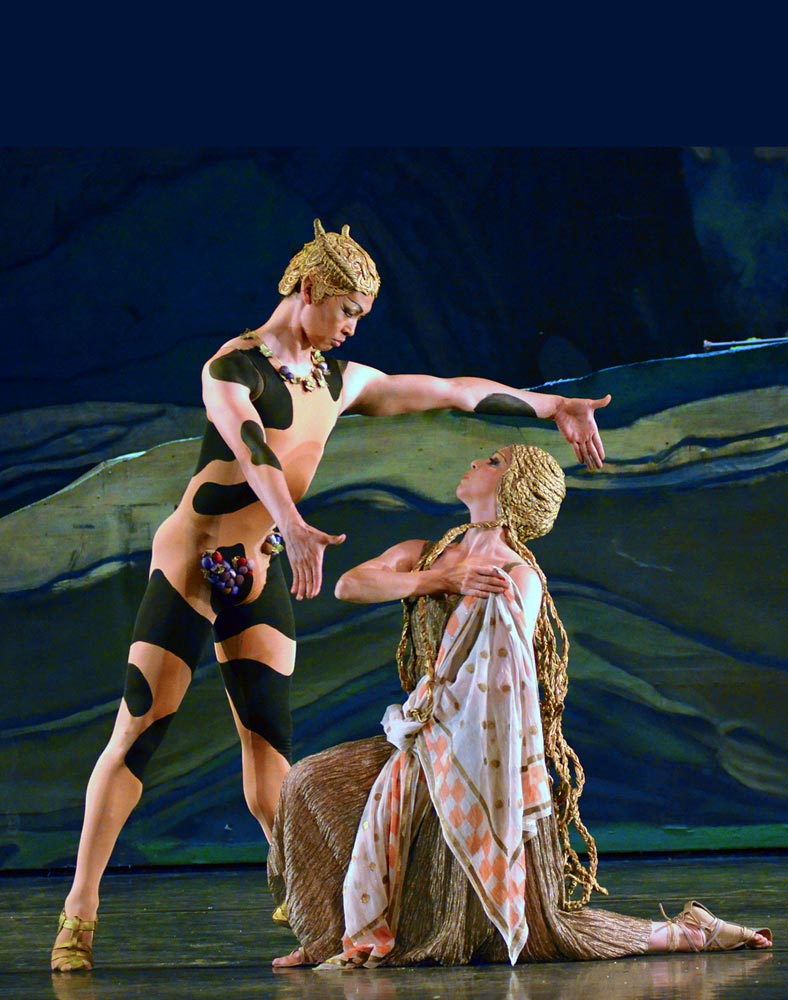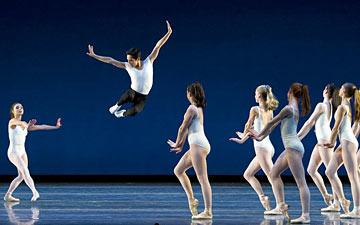
© Dave Morgan. (Click image for larger version)
Boston Ballet
Serenade, Afternoon of a Faun, Plan to B, Symphony in Three Movements
London, Coliseum
3 July 2013
Gallery of pictures by Dave Morgan
www.bostonballet.org
The first bravo for the Boston Ballet’s return to London must go to artistic director Mikko Nissinen, for his clever and highly successful programming for opening night. We’ve seen so many visiting companies start off with the wrong thing – a local favourite which doesn’t travel, a London favourite which our home companies do better, a poor production of a Petipa classic – and even if they’ve brought a whole treasury for the rest of their stay they never recover from the bad impression of a lukewarm reception and cool first night reviews. Nissinen chose to leave the full-evening works at home and brought instead a balanced, representative and interesting programme: Balanchine’s Serenade, loved by almost every one, then a nod to Europe with Nijinsky’s Afternoon of a Faun and the Finnish Jorma Elo’s Plan to B, and back to Balanchine for a knockout American finale, Symphony in Three Movements. The right things, in the right order.

© Dave Morgan. (Click image for larger version)
Even so, it must have been a tense experience for the dancers, and I’d guess they will look rather more relaxed in Serenade in later performances. Tchaikovsky’s gorgeous score must be some of the most danceable music ever written but that sense of unceasing ebb and flow in the dancing, complex but at the same time easy, wasn’t quite there. I felt that they know what they’re looking for, though, and Misa Kuranaga – leading the Russian section – has already found it: her lightness, swiftness and alert awareness were a pleasure to see.

© Dave Morgan. (Click image for larger version)
This company calls its Debussy ballet Afternoon of a Faun rather than by its French title, and in the context of the rest of the evening it’s not surprising that some people were expecting to see Jerome Robbins’ version, also in Boston’s current repertoire. I think Nijinsky’s original was the better choice, though, providing both a total contrast to the rest of the programme and the opportunity to see a rather unexpected and very effective performance from the Mongolian-born Altan Dugaraa as the Faun. It’s easy to forget how young Nijinsky was when he made this piece – 23-ish, depending on which of the differing opinions about his birth-year you believe – and although older dancers can make a very strong case for the benefit of experience, it’s also good to see a younger man’s take on the role. This faun was unmistakeably adolescent – a boy, who lies there in the sun every afternoon and thinks non-stop about sex. He can’t believe his luck when some real young women appear, but there’s a touch of teenage awkwardness about the way he handles the situation, and he’s not unhappy to be left to his solitary fantasies at the end. Dugaraa was completely convincing; I was less happy about the nymphs, whose movements seemed rather softer and less well-defined than usual. Lorna Feijoo was their leader – it was her only appearance of the evening and I would really like to have seen her in a more revealing role.

© Dave Morgan. (Click image for larger version)
Jorma Elo has been Boston Ballet’s resident choreographer since 2005 and from what I’ve seen, his ballets meet two of the essential requirements of the job: they make his dancers look fabulous and they whip his audience into whoops and yells of excitement. For me, though, they don’t look like ‘keepers’ – they haven’t the depth and the individuality to make me want to see them over and over, and with different casts. Plan to B runs exactly to this type – very fast, very physical, full of incredible jumps for the men, each episode is a thrill… and then it stops, having gone nowhere that I could detect. Much credit to the dancers, though, especially the men – it’s a wonderful show-off piece and they made the most of it.

© Dave Morgan. (Click image for larger version)
Symphony in Three Movements is relatively unknown in London and it’s good to see it again. It’s a strange mixture, with the high-energy and often near-chaotic power of the two outer movements framing the quiet mysteriousness of the central pas de deux. It’s also open to very different interpretations, from stern aggression to throwaway cheerfulness: the Boston version was on the smiley side, which made for an exhilarating 20 minutes but didn’t cut as deeply as Stravinsky’s score seems to demand. Kathleen Breen Combes and Paulo Arrais danced the second movement: it’s one of Balanchine’s greatest pas de deux, I think, and a rarity for me in that I feel the man’s contribution is more important than the woman’s. What it’s about is between you and the dancers: it’s a ritual of some sort, an eastern one probably, but that can be just sketched in, or given with all the dramatic weight at the man’s command. Either way it’s beautiful and intense and deeply involving. Arrais and Combes took it quite lightly, in keeping with the rest of the ballet; their control and commitment made it a high point of the evening.
A success, then – just a shame that they came in a season with so many other visiting companies and found it hard to fill the huge Coliseum.

















You must be logged in to post a comment.